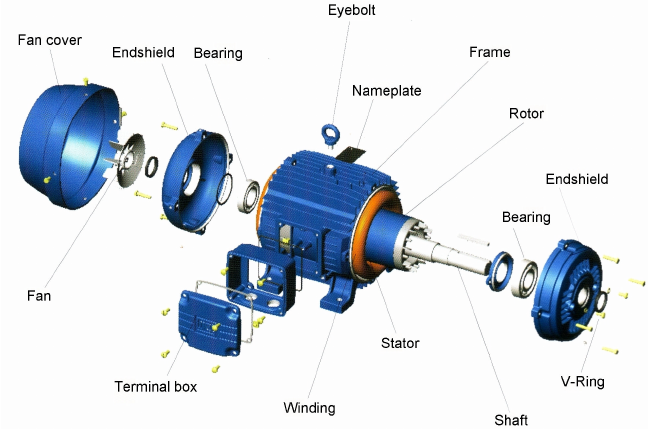Electric motor maintenance and management
strategies for better performance
Electric motors are significant in appliances, industries, and other types of automatic
systems. If you want to get efficient energy consumption, productivity and operational costs
then you have to follow the electric motor maintenance and management strategies. The
maintenance strategies are very important in preventing the faiure operations, decreasing
the fault rate. There is a complete details that will helps you in maintaining the motor and
prolong its life with enhnaced productivity.
Types of electric Motor maintenance and management
strategies
If you want a long life and inspection of any electric instrument, then maintenance is very
important. It reduces damages to the instruments and the failure rate; that is why here
maintenance of electric motors is divided into three types. These types are given as
- Preventive motor maintenance
This type of motor maintenance ensures the reliable operation of motors by preventing
problems in the operation. It is a schedule-based maintenance program in which action is
properly scheduled without depending on the condition of the equipment.
Advantages
● Increasing the life cycle of the equipment.
● Providing flexibility that helps in adjusting the maintenance periodicity.
● Proving very cost-efficient in many major processes.
● It is saving energy.
Disadvantages
● Labour-intensive
● Still chances of catastrophic failure
● The unneeded maintenance may affect the performance
● Unneeded maintenance causes incidental damage to the motor’s components. - Predictive Motor Maintenance
The predictive motors make sure the maintenance is at the right time. But here you have to
check the motor daily so that you can solve any problem before it produces any serious
issues. It is also known as a condition-based or predictive motor because different tools are
used in it, such as a thermal camera or vibration analysis, for checking the motor. You can
repair the motor before failure and make the maintenance attractive - Advantages
- ● Increasing the life cycle of the equipment.
- ● Providing flexibility that helps in adjusting the maintenance periodicity.
- ● Proving very cost-efficient in many major processes.
- ● It is saving energy.
- Disadvantages
- ● Labour-intensive
- ● Still chances of catastrophic failure
- ● The unneeded maintenance may affect the performance
- ● Unneeded maintenance causes incidental damage to the motor’s components.
- Predictive Motor Maintenance
The predictive motors make sure the maintenance is at the right time. But here you have to
check the motor daily so that you can solve any problem before it produces any serious
issues. It is also known as a condition-based or predictive motor because different tools are
used in it, such as a thermal camera or vibration analysis, for checking the motor. You can
repair the motor before failure and make the maintenance attractive.
Advantages
● Taking very little downtime for the process.
● Saving energy
● Giving long life to the parts and providing better motor performance.
● Charging low for repairing or labor repairs
● Safe for both the environment and workers
Disadvantages
● Extra money is required for training staff and purchasing tools. - Reactive Motor Maintenance
It is also known as “breakdown maintenance because it does not require any regular tests or
services as in predictive maintenance. It is working on the run it till it breaks mode
because its purpose is to repair the motor or replace it when it moves to failure.
Advantages
● Working on a very low budget because fewer lubricants and test tools are required.
● Consists of fewer staff.
Disadvantages
● Cost is required to repair or change the motor.
● Sometimes, more workers are required for overtime, which enhances the budget.
● Due to the failure of equipment, secondary equipment or processes may be
damaged.
Routine maintenance of AC and DC motors
The routine maintenance of the motors requires daily checks and different tasks that you
have to perform at multiple intervals.
Frequently maintenance activities (daily/weekly)
● Remove extra oil and dust from the motor daily.
● Check the oil leaks and levels.
● Make sure that the oil rings are turning with the shaft.
● Check the fuses, connections, and starter switch.
● Ensure that the grease and oil are on the bearings.
Every 6 months, checks
● Brushes that are half worn, check and replace all these to enhance the performance
rate.
● Check the brush position and pressure, clean and inspect the brush holder.
● Check, clean and replace the oil in sleeve bearing.
● Check the grease in roller bearings or balls.
● Test current input and check the operating speed. - Clean the motor by blowing out all the dirt on it and wipe brushes and commutators. Annually checks
- ● Clean out the magnetic dirt and test insulations.
- ● Replace the grease in the roller bearings or balls.
- ● Check the armature coils, commutators, and armature bands.
- ● Check the clearness between journal boxes and shafts. What are the benefits of electric motor maintenance and management strategies? Some benefits of the electric motor management strategies are given below:
- ● Decreasing the downtime of the motor and unexpected failure that causes the stoppages of the production.
- ● Maintenance and management steps prolong the lifetime of the electric motors and their components.
- ● It is saving your cost because emergency repair is much more costly than preventive maintenance. How to implement the electric motors maintenance and management strategies? If you want to implement the management program effectively, then follow the steps:
- ● Check the complete motor to analyze the current position of the motor and then take the necessary repair steps.
- ● Assess the motor conditions and quickly identify the risks of the motor’s failure.
- ● According to the situation of the motor, develop the strategy of maintaining the motor as given above.
- ● If there is any major issue that you cannot handle, then call the technician or the expert for the issue that you are facing. Common causes of electric motor failures Some causes of failures of motors are given as:
- ● Bearing wear and tear
- ● Imbalance or vibrations
- ● Improper installations
- ● Shaft misalignment
- ● Dirt, chemicals and moisture contamination
- ● Breakdown of electric insulations
- ● Overheating Conclusion In short, electric motor maintenance and management strategies are helping in reducing the breakdown time, performing smooth operation, prolonging the life, and reducing the cost. Industries use these strategies, they can enhance their productivity and efficiency on a very low budget. With the technology, use modern tools to check and inspect the motor’s condition. So, follow the management program and increase the lifetime of the electric motors.


